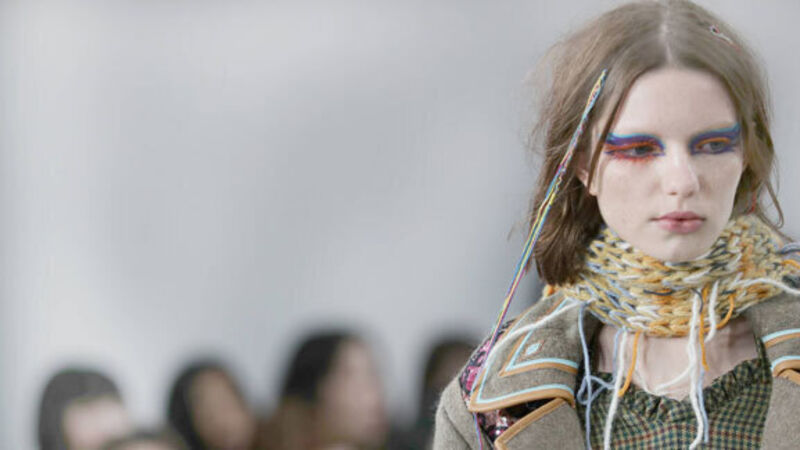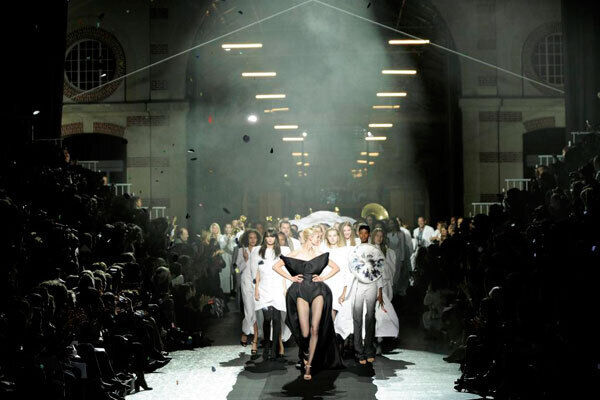Jenny Meirens: The woman behind the Maison Margiela label

If ever the notion of a status symbol was subverted, it was with the birth of the blank white Maison Martin Margiela label.
Conceived one evening in 1988 at a little bar in Mantova, Italy, when power-dressing was at its height, the idea was that only those in the know would be able to determine its significance, or even be able to tell if a garment was “designer” in the first place.
And what — cue the tap of a polished red fingernail — was the point of that?
For Margiela and Jenny Meirens, his creative and business partner, making a nameless calling card represented a belief in the inherent quality of design, not to mention satisfied their mischievous streak.
“I was certain we shouldn’t — we couldn’t — just come out with something that read Martin Margiela,” says Meirens, who came up with the idea.
“When people come into a shop and see strong clothes with no name on them they are going to be more curious.’”
Margiela was reticent, but ultimately agreed, on one condition: Four white stitches, visible only on the outside of unlined garments, would be added.
“Our lawyer couldn’t believe it because, of course, you cannot protect a blank space,” Meirens says.
“We lied to him and said we were going to print it with Martin Margiela on the reverse side. But we never did.”
In that small gesture, one of the most influential partnerships in fashion history was forged.
Margiela’s take on glamour was maverick to the point of fashion anarchy: Imagine a floor-length T-shirt printed with trompe l’oeil sequins, a woman’s jacket scaled up to an Italian men’s size 60 or another based on a Stockman dressmaker dummy, in lettered and numbered linen, all worn with a split-toe tabi boot.
His skilled tailoring was the envy of his contemporaries and a beacon for generations to come.
Like that label, and despite critical acclaim, Meirens and Margiela remained almost entirely anonymous throughout their 16-year partnership, refusing to be photographed or to speak to the press.

In 2008, I wrote, “Even after 20 years in business, Martin Margiela is still the most elusive figure in fashion — which might explain why designers feel so free to thumb through his archives for inspiration.”
The story was illustrated with five catwalk looks by Marc Jacobs, AF Vandevorst, Junya Watanabe, Hermès and Prada, above which were printed the original Margiela references.
Fashion has always borrowed heavily from Margiela.
However, seven years after his retirement from fashion, and well over a decade since Meirens moved on, having sold a majority stake in the company to Only the Brave founder Renzo Rosso in 2002, their impact on the industry has never seemed so potent.
That applies not only to clothing design, but to marketing, fashion photography and styling. Raf Simons has openly paid homage to Martin Margiela.
Vetements and Balenciaga are indebted to his aesthetic. Emerging designers including Vejas, Marques Almeida and Jacquemus all nod to his archive. So does Kanye West.
The luxury goods market is oversaturated, and because of that, fashion is moving toward a more low-profile, lo-fi authenticity that is deeply rooted in the purposefully anti-establishment mindset that Margiela and Meirens pioneered.
Today, Meirens is 72, a small-framed blonde with bright blue eyes in a loose-fitting, ankle-length black silk dress. It is vintage Martin Margiela, which, she will say later, is all that she ever wears.
Her home is located high on a hilltop in splendid isolation in Pajottenland, a gently rolling landscape dedicated predominantly to farming, about 45 minutes drive west of Brussels.
Constructed from the ground up under Meirens’s watchful gaze, the building’s facade is clad in broad planks of unvarnished wood and glass.
The view is spectacular and despite the hazy heat outside, the minimally-furnished interior is cool and dimly lit.
If Margiela was the designer, Meirens was his foil and facilitator, the woman who made sure he had everything he needed to make, sustain and amplify the name.
“We were totally financially and creatively independent,” Meirens says, and that was her doing.
“We never had any money but we were never in debt. There was just enough to go on.”
Far more important: “Of course it was all about being free. That was always the point.”
The collaboration between Meirens and Margiela resulted in the creation of a complete and entirely distinctive world, long before fashion was spoken about in those terms.
As opposed to seeking high visibility and expressing a single creative vision, the house relied on the projection of a team.
The label’s twice-yearly fashion shows eschewed the requisite hierarchy of a seating plan, instead positioning buyers and press on a first-come, first-serve basis. And that’s when there were seats.
Margiela presented his shows everywhere from a derelict school playground on the outskirts of Paris to Montmartre Cemetery: For spring 1993, two shows took place at either end of the graveyard, one all white, the other all black, with invitations to match.
For fall 1997, the collection was unveiled at three different locations around the French capital with models, in wigs cut from vintage fur coats, ferried from place to place on a rented bus and accompanied by a suitably lugubrious Belgian brass band.
By the time they arrived, the waiting crowd was somewhat the worse for wear, having over-imbibed the robust red wine served in white plastic cups at every Margiela show.
Show casting was equally unconventional. Models were sought out from the street or from a circle of friends outside fashion. If today that is commonplace, at the time it was unprecedented.
“Of course, it’s easier to do fittings on professional models,” Meirens says.
“But I don’t like the idea that women need to be perfect. I prefer a woman on the street who can express something. I prefer a strong woman to a beautiful woman...”
Faces were also often veiled, focusing the attention entirely on the clothes.
At every turn, Margiela railed against the fashion system. For its fall 1989 show, Meirens placed a classified ad including the time, date and address of the show in a free newspaper.
Once published, the Margiela team picked up hundreds of copies, ringed the relevant text in red and mailed it out.
“It was the cheapest invitation ever,” Meirens says.
On another occasion, buyers and press received an unremarkable white card with a phone number, which they called only to reach a voicemail telling them when and where to attend the show.
However radical, none of these concepts would have meant anything without the clothes.
“For me, one of the strongest things about Martin was him taking something very popular, common or cheap and turning it into something chic,” Meirens says.
He consistently used inexpensive men’s suiting and shiny black lining fabric. He made chubby coats out of silver Christmas tinsel and sheath dresses out of gold plastic rings.
Then there were the gently frayed hems, the reversed seams, the reinventing of vintage finds from leather butchers’ aprons to antique wedding dresses — the turning of clothes literally upside down and inside out.
Struggling to find words to describe Margiela’s work, critics labelled it “deconstructed,” though that was never a term adopted by the house. Any play between the haute and the humble aside, he was a masterful technician. The Margiela shoulder in particular — either strong, high and narrow or extremely broad — has been studied ad infinitum.
In 1997, Meirens brokered a deal that led to Margiela’s being appointed creative director of Hermès.
Margiela’s tenure at Hermès lasted six years and, far from undermining the company’s proudly conservative approach, resulted in timelessly beautiful, understated and luxurious clothes. For Meirens, the deal with Hermès was principally a practical one.
“All the money went back into the company,” she says, referring to Maison Martin Margiela.
hile a certain nostalgia now decrees that the brand, and Margiela,
were universally respected, even revered, that was not always the case. Meirens generally employed people with no fashion background, finding more conventional industry hires “hysterical”.
One of those hires was Patrick Scallon, who led the communications team from 1993 to 2008: “People look at Margiela now through rose-tinted glasses,” Scallon says.
“They forget that at the time they disliked Martin’s work at Hermès. How dare someone so talented do something so commercial, so boring? They also often hated Margiela shows. It’s important that people understand the price of being Margiela. We didn’t advertise.
"The designer wasn’t having lunch with editors to curry favour. Our offices were in the 18th Arrondissement, in a very nice place, but the area was not a comfortable or convenient destination for our visitors. At the shows, there was no seating plan. The hate calls we received the morning after were unbelievable.”
Not that it was easy to find a phone number to register a complaint. The company name Sarl Neuf (Meirens and Margiela’s shared lucky number is nine) was listed, but Maison Martin Margiela was not.
“Jenny enjoyed the intrigue, the provocation, the effort required,” he says.
Meirens met Margiela in 1983 when she was judging the Golden Spindle Award, an annual competition conceived by the Belgian textile industry. He was an entrant. Belgian fashion was nascent in the collective consciousness.
Dirk Van Saene — who graduated from the Antwerp’s Royal Academy of Fine Arts a year after Margiela, and was part of what came to be known as the Antwerp Six — took the top prize. But Meirens had argued for Margiela.
“For me, it was the best. I had quite a fight with them,” she remembers, smiling.
“The clothes were inspired by surgeons’ scrubs, the skirts were huge and the shoes beautiful, very strong, a masculine upper with a low, heavy heel.” Soon after, Meirens offered the fledgling talent a week to sell his collection in her groundbreaking store, Crea, which had opened earlier that year and was located on Place St Catherine in the centre of Brussels, in an area known more for its fish markets than fashion.
“Jenny definitely launched that neighbourhood into what it is today, Brussels’s most hyped designer area,” Margiela confirms today.
“They owe her a statue.”
t Crea, Meirens introduced the designs of Belgian modernists, including France Andrevie, a rising Frenchman named Claude Montana, and Yohji Yamamoto, a recent and explosive entry onto the Paris fashion scene.
Her shop was the place to go for an alternative to the prevailing jolie madame aesthetic.
“What I always hated was women who needed to look sexy,” Meirens says.
“I think you’re sexy or you’re not. It’s not because you show breasts or legs that you’re sexy.”
Margiela recalls being impressed that in her shop she arranged displays by colour, not designer brand.
“Though the shop was quite small, the fitting room was its match,” he says.
“It was here she would advise her customers, acting more as a styling consultant or ‘personal shopper’ than simply a shop owner.
“Back then, she held a fashion designer exhibition with artist Gorik Lindemans. She often acted as a talent scout, attracted to the artistic and very creative people around.
"She discovered my work, she was intrigued by it, so we started seeing each other on a regular basis.”
In 1984, Meirens decided she wanted to open Belgium’s first Comme des Garçons store. She recalls the first time she travelled to Tokyo for a meeting with Rei Kawakubo.
“I was totally dressed in Margiela, including my shoes,” she says.
“She was looking at me and saying nothing until, in the end, I said: ‘What do you think of my clothes?’ And she said: ‘I like your shoes a lot,’ and she ordered a pair. I went back to my room and called Martin in the middle of the night. ‘Martin, I sold a pair of your shoes to Rei Kawakubo.’ Of course, he was so happy.”
Kawakubo agreed to Meirens’s proposition, and to this day is still impressed with her forward thinking.
As Kawakubo says, “Jenny is a strong person whose policy was to make her work about strong and new clothes” — a statement that, coming from another great fashion enigma of few words, is high praise.
“She’s an extremely powerful personality, a self-made woman,” says Raf Simons, who became acquainted with Meirens during his years as creative director at Jil Sander, and eventually rented her seaside house in Puglia, Italy, every summer from 2005 to 2011.
They would spend a few days together before she would turn the property over to him.
Margiela recognised a rare kinship in Meirens, and in 1988 he left his job in Paris heading up Jean-Paul Gaultier’s design team to go into business with her.
“We felt ready to start a fashion experience together, our fashion house that would become Maison Martin Margiela,” he says.
“We shared ideas back and forth for a whole year, she on structuring the strategy and I on inventing the style of the collections.”
“It was always a conversation, it came out of brainstorming,” she says.
“At the beginning it was only Martin and myself.”
She spent the workweek in the French capital, where Margiela was based, doing everything from raising funds to advising him in fittings.
“If I said a woman might not like this or that, he listened,” she says.
“He took it very seriously.”
She returned to Belgium each weekend, to maintain her businesses in order to support the new venture and to take care of her two children, Sophie and Frank, whose father she’d separated from some time before.
“I was working very, very, very hard,” she says.
“With little money, I would drive to Paris, and there were times when I was worried about filling the petrol tank.”
“For me everything seemed normal,” her daughter Sophie says.
“Jenny was quite absent, and she left us to find things out for ourselves. She didn’t hold our hands. She would come back at the weekend to cook and fill the fridge. It was when Post-it notes came out. She loved them.
"The house was always full of instructions: ‘Clean the bathtub after you take a shower, do this, do that, like this, like that’.”
Sophie would go on to work with her mother at Margiela.
“Even before they started the company, Jenny and Martin were always together,” she says.
“It really was like two souls that found each other in their extreme passions.” Meirens and Margiela were, in many ways, perfectly complementary.
“Jenny brought a lot of things to the table,” Raf Simons says.
“She’s also a business mind, you know, a woman who really, really wanted to create a business. The things that were coming out of Martin at the time were quite extreme. To connect the idea of that with, ‘OK, let’s start a company,’ makes Jenny quite a pioneer.
"It was a very different time from now. It was not meant to be immediately about doing big business. It was really about Jenny and Martin knowing each other’s strengths.
"I think she was really sticking her neck out, taking responsibility, taking care of things that normally other people would take care of, so Martin could be totally free.”
By the time Meirens retired, in 2003, she had taken Margiela as far as she felt she was able to.
“I was tired,” she says.
The fashion pendulum had swung back toward branded product and trophy dressing, the very things she had always fought against.
With the money she received from the sale of the company, she bought the seaside home in Puglia, a little dog she named Luna and the land for the house on a hill in Pajottenland, where she spends most of her time now.
he house is painted black. But it was the use of its negative, white — or in Margiela speak “whites” — that is the most familiar Margiela signature.
The team at Maison Martin Margiela, now under the helm of John Galliano, always wore and still wear a Margiela reworking of blouses blanches, the white coats sported by models between fittings and, in the shorter form, the petites mains who staff the Paris ateliers.
Margiela’s headquarters were painted white from floor to ceiling with furniture sought out in thrift shops and shrouded in white cotton. He enjoyed the way white aged and the fact of time passing expressed by any discolourations.
It was also cost-effective. True to the make-do-and-mend mindset shared by Margiela and Meirens, it lent a certain distinction and clarity to the environment. Scallon recalls that each evening the outgoing mail would be sewn shut in white cotton envelopes in place of paper ones.
“One day in the office I said to Martin that we had to send a thank-you gift,” he says.
“Martin went into the bin, took out a white plastic grocery bag and knotted it into an angel.” “Even if she saw the world in black, I saw the world in white,” Margiela says.
“And, besides our generation gap, we intrigued, challenged and amazed each other. It became a full symbiosis. For a young fashion designer, the beginning is utterly important, so I remain grateful that Jenny managed it to structure my wildest dreams into a viable business.”
Upstairs at Meirens’s home, three small vintage frames hang one above the other on the landing over a large chest of drawers. They are empty — blank — their canvases roughly cut away to expose aged wooden backings, an echo of the by-now famous Martin Margiela label.
With a modesty that belies her contribution to the shaping of contemporary fashion, Meirens says that the “freedom of creative expression and the courage and conviction” that small piece of untreated white cotton represents is her proudest achievement.











